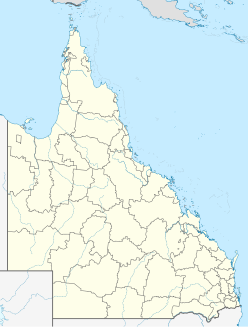Lawn Hill crater
| Lawn Hill crater | |
|---|---|
 Landsat image of Lawn Hill crater (circular feature in centre); screen capture from NASA World Wind | |
| Impact crater/structure | |
| Confidence | Confirmed |
| Diameter | 18 km (11 mi) |
| Age | Ordovician |
| Exposed | Yes |
| Drilled | No |
| Location | |
| Coordinates | 18°40′01″S 138°37′48″E / 18.667°S 138.63°E |
| Country | Australia |
| State | Queensland |
Lawn Hill ‘crater’ refers to an Ordovician impact structure, the eroded remnant of a former impact crater, situated approximately 220 km north-north-west of Mount Isa in northwestern Queensland, Australia. The site is marked by an 18 km diameter ring of dolomite hills. The origin of this circular feature was uncertain until the discovery of shatter cones and shocked quartz from uplifted rocks at the centre was reported in 1987.[1][2]
Description
[edit]
The site is eroded and it has been suggested that the original crater was slightly larger, at around 20 km diameter.[3] In the past it has been debated whether the limestones, which are of Middle Cambrian age (ca. 510 Ma) based on comparisons with nearby outcrops of marine limestone in the Georgina Basin, were simply deposited in the crater after its formation, or were actually deformed by the impact event.[4] Those differing points of view suggest that the crater may be of earlier Cambrian or Proterozoic age, or it could be of younger Paleozoic age. Although one recent study concluded that the impact most likely happened just before or even during the early stages of deposition of the limestone, suggesting an age of around 509–506 Ma (Middle Cambrian),[5] the age of the impact structure is now thought to be Ordovician (ca. 472 Ma) based on 40Ar-39Ar dating of impact-related melt particles.[6] The Georgina Basin was still an active depocenter at that time and the excellent preservation of the structure is attributed to burial by post-impact sedimentation.
References
[edit]- ^ Stewart A, Mitchell K (1987). "Shatter cones at the Lawn Hill circular structure, northwestern Queensland; presumed astrobleme". Australian Journal of Earth Sciences. 34 (4): 477–485. Bibcode:1987AuJES..34..477S. doi:10.1080/08120098708729427.
- ^ "Lawn Hill". Earth Impact Database. Planetary and Space Science Centre University of New Brunswick Fredericton. Retrieved 2009-08-19.
- ^ Shoemaker EM, Shoemaker CS (1996). "The Proterozoic impact record of Australia". AGSO Journal of Australian Geology & Geophysics. 16 (4): 379–398. Bibcode:1996JAuGG..16..379S.
- ^ Haines PW (2005). "Impact cratering and distal ejecta: the Australian record". Australian Journal of Earth Sciences. 52 (4–5): 481–507. Bibcode:2005AuJES..52..481H. doi:10.1080/08120090500170351. S2CID 128705406. Abstract
- ^ Lindsay J, Brasier M (2006). "Impact Craters as biospheric microenvironments, Lawn Hill Structure, Northern Australia". Astrobiology. 6 (2): 348–363. Bibcode:2006AsBio...6..348L. doi:10.1089/ast.2006.6.348. PMID 16689651. S2CID 20466013. Abstract
- ^ Darlington, Vicki; Blenkinsop, Tom; Dirks, Paul; Salisbury, Jess; Tomkins, Andrew (2016). "The Lawn Hill annulus: An Ordovician meteorite impact into water-saturated dolomite". Meteoritics & Planetary Science. 51 (12): 2416–2440. Bibcode:2016M&PS...51.2416D. doi:10.1111/maps.12734. S2CID 53643087. Retrieved 9 November 2020.



